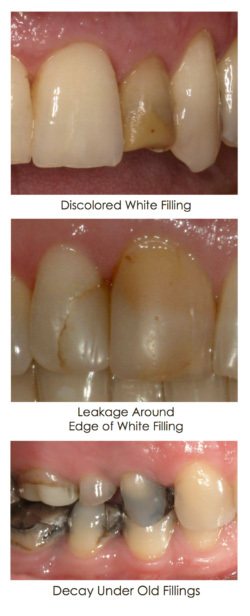
Discolored Fillings: What to Do When Your Fillings Look Bad
If you notice that your dental fillings have become discolored, it’s important to take action to address the issue. Discoloration can occur due to a variety of reasons, such as staining from food and drinks or deterioration of the filling material over time.
Here are some steps to follow when your fillings look bad:
1. Schedule an appointment with your dentist to have the fillings evaluated. They will be able to determine the cause of the discoloration and recommend the appropriate treatment.
2. Depending on the severity of the discoloration, your dentist may suggest replacing the fillings with new ones. This can help improve the appearance and functionality of your teeth.
3. In some cases, a professional cleaning or polishing may be sufficient to remove surface stains and restore the natural color of the fillings.Remember, regular dental check-ups and good oral hygiene practices can help prevent discoloration and maintain the longevity of your dental fillings.

Discolored Fillings: What to Do When Your Fillings Look Bad
Having dental fillings is a common procedure to restore teeth affected by cavities. However, over time, these fillings can become discolored, causing them to stand out and affect the appearance of your smile. If you’re dealing with discolored fillings, there are several options available to address this issue and restore the natural look of your teeth.
Understanding Discolored Fillings
Discolored fillings can occur for various reasons. One common cause is the material used for the filling. Amalgam fillings, which are made of a combination of metals, can darken over time. Composite fillings, made of a resin material, can also become discolored due to staining from food and beverages.
Additionally, poor oral hygiene can contribute to the discoloration of fillings. If you neglect proper brushing and flossing, plaque and tartar can build up around the fillings, leading to stains and discoloration. It’s essential to maintain good oral hygiene practices to prevent this issue.
Options for Addressing Discolored Fillings
If you’re unhappy with the appearance of your discolored fillings, there are several options to consider:
1. Dental Bonding
Dental bonding is a cosmetic procedure that involves applying a tooth-colored resin material to the surface of the discolored filling. The resin is shaped and molded to match the natural contours of your teeth, effectively masking the discoloration.
This option is a quick and relatively inexpensive solution to improve the appearance of discolored fillings. However, dental bonding may not be as durable as other options and may require touch-ups or replacements over time.
2. Porcelain Veneers
Porcelain veneers are thin shells made of dental ceramic that are bonded to the front surface of your teeth. They can effectively cover up discolored fillings, giving you a bright and uniform smile. Veneers are known for their durability and natural appearance, making them a long-lasting solution for addressing discolored fillings.
However, it’s important to note that getting porcelain veneers is a more extensive procedure compared to dental bonding. It involves removing a small amount of enamel from your teeth to accommodate the veneer, and the process typically requires multiple visits to the dentist.
3. Replacement Fillings
If your fillings are severely discolored or damaged, your dentist may recommend replacing them with new fillings. This option allows you to choose a different material that is less prone to discoloration, such as tooth-colored composite fillings or ceramic inlays or onlays.
Before deciding on replacement fillings, it’s important to consult with your dentist to determine the best material for your specific needs. They can assess the condition of your current fillings and recommend the most suitable option for you.
Remember, it’s essential to maintain regular dental check-ups and cleanings to prevent further discoloration of your fillings. Your dentist can provide professional cleaning and polishing to remove surface stains and help keep your fillings looking their best.
Preventing Discoloration of Fillings
While it’s impossible to completely prevent discoloration of fillings, there are steps you can take to minimize the risk:
1. Practice Good Oral Hygiene
Brush your teeth at least twice a day and floss daily to remove plaque and prevent staining. Using a whitening toothpaste can also help remove surface stains and maintain the whiteness of your teeth.
2. Avoid Staining Foods and Drinks
Limit your consumption of foods and beverages that are known to stain teeth, such as coffee, tea, red wine, and dark berries. If you do indulge in these items, rinse your mouth with water afterward to minimize the staining effect.
3. Quit Smoking
Smoking is a significant contributor to tooth discoloration, including fillings. Quitting smoking not only improves your overall health but also helps maintain the appearance of your teeth and fillings.
4. Regular Dental Cleanings
Visit your dentist regularly for professional cleanings and check-ups. Your dentist can remove plaque, tartar, and surface stains that can contribute to the discoloration of fillings.
5. Consider Tooth Whitening
If you’re concerned about the overall color of your teeth, including your fillings, you can explore tooth whitening options. Professional teeth whitening treatments can help brighten your smile and minimize the appearance of any discolored fillings.
By following these preventive measures and seeking appropriate treatment options, you can effectively address discolored fillings and restore the natural beauty of your smile.
Key Takeaways: Discolored Fillings
- If your fillings look bad, don’t panic!
- Consult your dentist to determine the cause of discoloration.
- Consider professional teeth whitening to improve the appearance.
- Replacing discolored fillings may be an option.
- Maintain good oral hygiene to prevent future discoloration.
Frequently Asked Questions
Why do fillings become discolored?
Fillings can become discolored due to a variety of reasons. One common cause is the natural aging process of the filling material itself. Over time, the material may start to break down or wear away, leading to discoloration. Additionally, certain foods and beverages such as coffee, tea, red wine, and tobacco can stain the filling. Poor oral hygiene practices can also contribute to the discoloration of fillings.
To prevent or minimize discoloration, it is important to maintain good oral hygiene habits, avoid consuming staining substances, and visit your dentist regularly for check-ups and cleanings. If your fillings have become severely discolored, it may be necessary to have them replaced by your dentist.
Can discolored fillings be whitened?
Unlike natural teeth, it is not possible to whiten discolored fillings using conventional teeth whitening methods. Teeth whitening treatments typically work by bleaching the natural tooth enamel, which does not affect the color of fillings. If you have discolored fillings and wish to improve their appearance, you may consider discussing alternative options with your dentist.
Your dentist may recommend replacing the discolored fillings with new ones that match the color of your natural teeth. Alternatively, they may suggest other cosmetic dental treatments such as dental bonding or porcelain veneers to enhance the overall aesthetics of your smile.
What are the alternatives to discolored fillings?
If you have discolored fillings and are unhappy with their appearance, there are several alternatives you can explore with your dentist. One option is to have the fillings replaced with tooth-colored composite fillings. These fillings are made from a resin material that can be matched to the color of your natural teeth, providing a more seamless and natural-looking result.
In cases where the fillings are extensive or require additional support, your dentist may recommend porcelain or ceramic inlays or onlays. These restorations are custom-made in a dental laboratory and can be color-matched to your natural teeth for a more aesthetically pleasing outcome.
How long do fillings typically last?
The lifespan of fillings can vary depending on several factors, including the type of filling material used, the location of the filling in the mouth, your oral hygiene habits, and your overall dental health. On average, silver amalgam fillings can last around 10 to 15 years, while tooth-colored composite fillings may last between 7 to 10 years.
However, it is important to note that fillings are not meant to last a lifetime and may eventually need to be replaced. Regular dental check-ups and cleanings can help your dentist monitor the condition of your fillings and determine when they may need to be repaired or replaced.
How can I prevent future discoloration of fillings?
To prevent future discoloration of fillings, it is crucial to maintain good oral hygiene practices. This includes brushing your teeth at least twice a day with a fluoride toothpaste, flossing daily, and using an antiseptic mouthwash. Regular dental check-ups and professional cleanings are also essential for removing plaque and tartar buildup that can contribute to staining.
Avoiding or minimizing the consumption of staining substances such as coffee, tea, red wine, and tobacco can also help prevent discoloration. If you do consume these substances, it is a good idea to rinse your mouth with water afterward and brush your teeth as soon as possible to reduce the chances of staining.
do you REALLY need to get a CAVITY filled?
Final Summary
Call or Book appointment online
:Ace Dental Care Alpharetta office: 678-562-1555 - Book Now
Ace Dental Care Norcross office: 770-806-1255 - Book Now
Disclaimer
This blog post was generated by artificial intelligence. The content of this post may not be accurate or complete, and should not be relied upon as a substitute for professional advice. If you have any questions about the content of this post, please contact us.
We are constantly working to improve the accuracy and quality of our AI-generated content. However, there may still be errors or inaccuracies. We apologize for any inconvenience this may cause.





